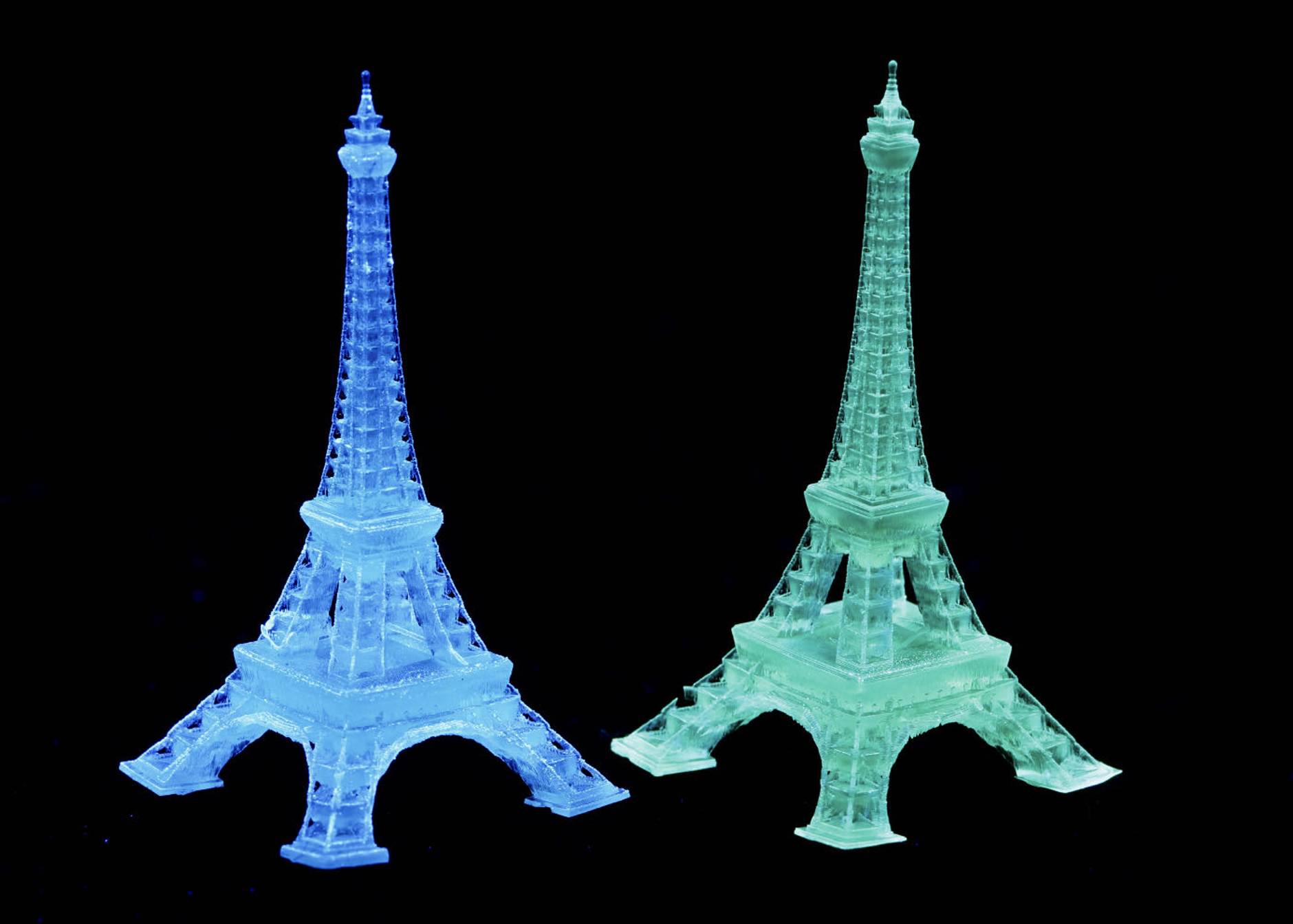"The alphabet movie serves as a compelling example that illustrates the application of emissive thin films like supramolecular ink in the creation of fast-switching displays," said Zhu.
Additional experiments at UC Berkeley showed that the supramolecular ink is also compatible with 3D printing technologies such as for the design of decorative OLED lighting.
Zhu added that manufacturers could also use the supramolecular ink to fabricate wearable devices or high-tech clothing that illuminates for safety in low-light conditions, or wearable devices that display information through the supramolecular light-emitting structures.

Eiffel Tower-shaped luminescent structures 3D-printed from supramolecular ink. Each 2-centimeter-tall device is fabricated from supramolecular ink that emits blue or green light when exposed to 254-nanometer ultraviolet light. (Credit: Peidong Yang and Cheng Zhu/Berkeley Lab. Courtesy of Science)
The supramolecular ink is another demonstration from the Peidong Yang lab of new sustainable materials that could enable cost-effective and energy-efficient semiconductor manufacturing. Last year, Yang and his team reported a new "multielement ink" – the first "high-entropy" semiconductor that can be processed at low temperature or room temperature.
With their demonstrated stability and shelf life, the supramolecular ink compounds could also help in the commercial advancement of ionic halide perovskites, a thin-film solar material that the display industry has been eyeing for decades. With their low-temperature synthesis in solution, ionic halide perovskites could potentially enable cheaper manufacturing processes for the manufacturing of displays. But high-performance halide perovskites contain the element lead, which is concerning for the environment and public health. In contrast, the new supramolecular ink – which belongs to the ionic halide perovskite family – offers a lead-free formulation without compromising performance.
Now that they have successfully demonstrated the supramolecular ink's potential in OLED thin films and 3D-printable electronics, the researchers are now exploring the material's electroluminescent potential. "This involves a focused and specialized investigation into how well our materials can emit light using electrical excitation," Zhu said. "This step is essential to understanding our material's full potential for creating efficient light-emitting devices."
Other authors on the study include Jianbo Jin (co-first author), Zhen Wang, Zhenpeng Xu, Maria C. Folgueras, Yuxin Jiang, Can B. Uzundal, Han K.D. Le, Feng Wang, and Xiaoyu (Rayne) Zheng.
This work was supported by the Department of Energy's Office of Science.
The technology is available for licensing or collaborative research through Berkeley Lab's Intellectual Property Office. Contact ipo@lbl.gov for more information.
###
Lawrence Berkeley National Laboratory (Berkeley Lab) is committed to delivering solutions for humankind through research in clean energy, a healthy planet, and discovery science. Founded in 1931 on the belief that the biggest problems are best addressed by teams, Berkeley Lab and its scientists have been recognized with 16 Nobel Prizes. Researchers from around the world rely on the Lab's world-class scientific facilities for their own pioneering research. Berkeley Lab is a multiprogram national laboratory managed by the University of California for the U.S. Department of Energy's Office of Science.
DOE's Office of Science is the single largest supporter of basic research in the physical sciences in the United States, and is working to address some of the most pressing challenges of our time. For more information, please visit energy.gov/science.
Source
Berkeley Lab: Scientists Advance Affordable, Sustainable Solution for Flat-Panel Displays and Wearable Tech



